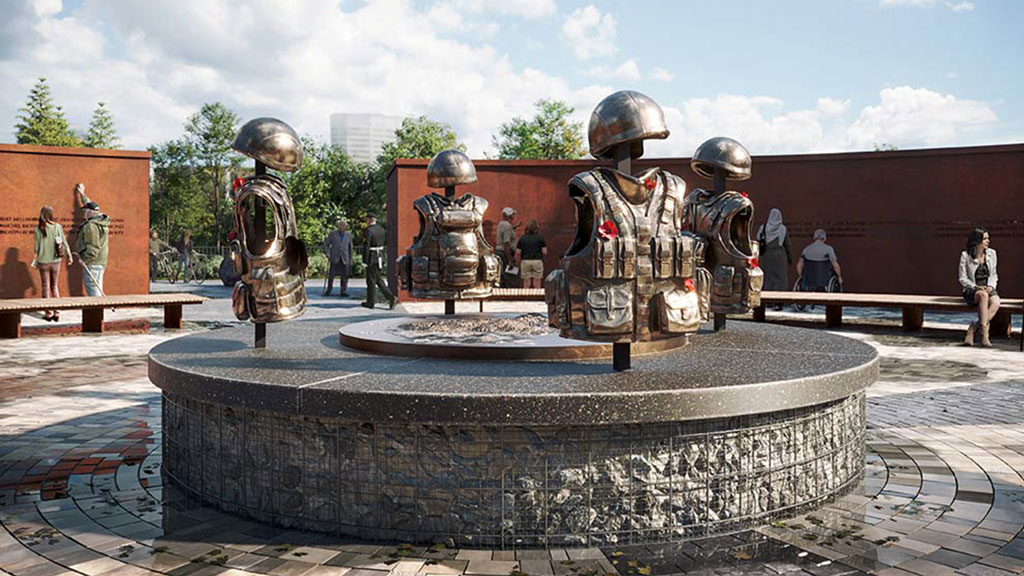OTTAWA — The federal government changed the final design choice for a proposed monument to Canada’s mission in Afghanistan following the Taliban’s takeover of the country, but Ottawa did not consult with veterans to see if they felt the situation warranted a change.
The monument is meant to “pay tribute to the commitment and sacrifice of Canadians in helping to rebuild Afghanistan,” according to its vision statement, but the government rejected the first design chosen by a jury and selected another option.
The Veterans’ Affairs Committee has already been studying the issue, but just before Christmas Conservative MP Blake Richards, frustrated with the lack of answers from the government, introduced a motion to order the government to hand over more documents to explain its decision.
“All we know is that the Prime Minister’s Office has interfered in this process that has delayed, at the very minimum, the construction of this monument,” Richards said at a committee meeting Dec. 21.
NDP MP Rachel Blaney said she will support the motion at a future meeting.
“We want these monuments to honour the people who worked hard, who sacrificed so much, and now there’s a whole bunch of questions and the government cannot answer them in a way that makes sense,” she said in an interview.
More than 40,000 Canadian soldiers, and hundreds more civilians and government officials, served in Afghanistan between 2001 and 2014. Seven civilians and 158 Canadian Armed Forces members died. The former Conservative government announced plans to build a national monument to the mission in 2014.
A design competition was launched in August 2019.
In November 2021, a jury tasked with reviewing proposals for the monument chose design by Team Daoust, made up of the firm Daoust Lestage Lizotte Stecker, artist Luca Fortin and former Supreme Court justice Louise Arbour. Team Daoust described its lace-like stone wall as referring “to a view of the world through the magnified motif of a burqa, a view opened up by the axis of democracy.”
That selection came three months after Kabul fell to the Taliban, leading to sweeping changes and a backsliding of women’s rights, including extreme restrictions on girls’ education.
Shortly after the design was chosen, government officials began to question internally if it was the right vision given the changes in Afghanistan.
Ultimately the government went with a different option. Last June then-veterans affairs minister Lawrence MacAulay announced the monument would instead be designed by Indigenous artist and Armed Forces veteran Adrian Stimson.
Stimson’s proposal included the names of Canadian soldiers killed in Afghanistan and featured a central segment with helmets and flak jackets arranged on crosses.
In documents released to the veterans affairs committee last fall, the jury acknowledged the Taliban’s impact since but also said that the Daoust design best reflected that the sacrifices made by Canadians in Afghanistan “were not in vain” particularly when it came to the education of women and girls in Afghanistan.
The documents show plans were made to consult with the families of the veterans who died in Afghanistan but those consultations never happened. They also show that the government warned by Heritage Canada officials that it couldn’t just overturn the jury’s choice and award the $3-million contract to someone else without risking a lawsuit.
But a month after that warning the government was considering doing just that. The documents show both the Prime Minister’s Office and Privy Council Office were involved in those discussions in mid-2022.
Notes prepared for a May 2022 meeting between officials from the Privy Council, Veterans Affairs and Heritage show they talked about launching consultations to help decide whether the vision for the monument was still valid, or if the process should be restarted.
The draft plan proposed reaching out to the design teams, jury members, veterans and families of those who died in Afghanistan to ask two specific questions: “Have your views on Canada’s involvement or achievements in Afghanistan changed over the past year? Is this vision still valid in light of the current situation in Afghanistan?”
The government will not answer questions as to why that plan was not put into action, citing solicitor-client privilege. A spokesperson for Veterans Affairs said in response to questions this week that it decided to instead rely upon feedback from an online, anonymous survey done in May and June 2021, seeking input on the five finalist designs.
Heritage Minister Pascale St-Onge and Veterans Affairs Minister Ginette Petitpas Taylor appeared at the veterans affairs committee last October to answer questions. Both insisted the government needed to listen to veterans and was using the survey to do so.
“I am shocked that we are questioning veterans … we are creating a monument for them, and we need to ensure that we’re listening to them,” St-Onge said in French.
Since the announcement in June, Team Daoust has launched a petition calling for the government to reverse its decision, arguing it did not follow its own rules for the design competition.
©2024 The Canadian Press











Recent Comments
comments for this post are closed